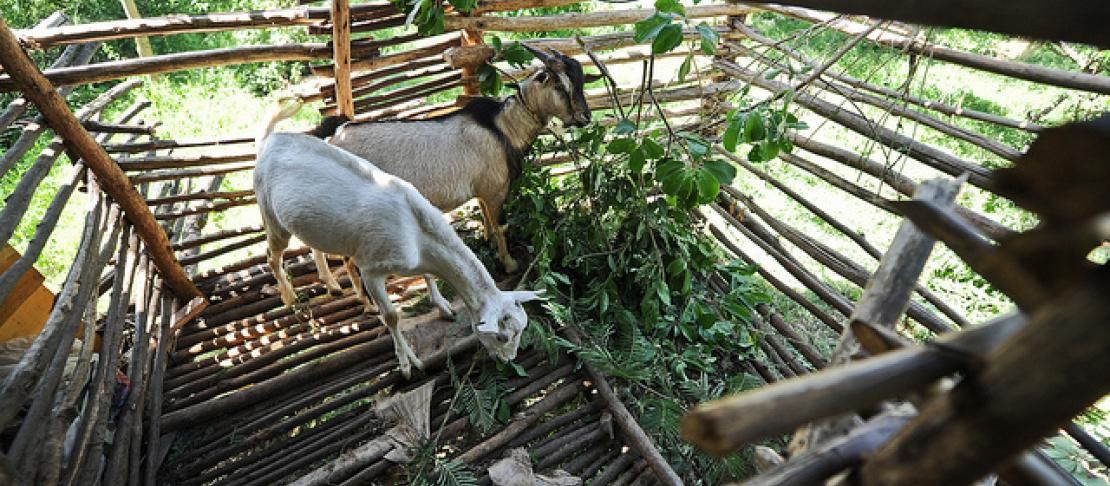Improving climate-smart agriculture decisions with better tools to evaluate tradeoffs and synergies

New special issue of journal presents nine papers with a variety of tools and methods
A new special issue of the journal Agricultural Systems has just been released online that features an introduction and nine papers addressing the issue of prioritising climate-smart agriculture (CSA) interventions at different scales. The special issue was organized by guest editors Dr. Philip Thornton (CCAFS Flagship Leader), Dr. Pramod Aggarwal (CCAFS South Asia Regional Program Leader), and Dr. David Parsons (from the Swedish University of Agricultural Sciences and the University of Tasmania).
Beginning with the premise that agricultural systems will need to be transformed if we are to cope with the challenges being created by negative effects of climate change, the guest editors propose that CSA offers hope in adapting our food systems to support food security. Increasing the adaptive capacity of farmers as well as increasing resilience and resource use efficiency in agricultural production systems can help reduce risks to food security. CSA should help coordinate action around climate-resilient pathways by building evidence, increasing institutional effectiveness, fostering coherence between climate and agriculture policies, and linking climate and agriculture financing.
Getting the many related actors working in tandem is not always easy, but the papers presented in the special issue offer a variety of ways to collect information, evaluate options, and work across levels–from farmers up to policymakers–to create context-specific solutions. Thornton, Aggarwal, and Parsons note in their introductory paper:
It is very unlikely that there are silver bullets that can deliver “climate smartness” in all contexts: some practices may be climate smart in one context but not in another, by delivering relatively more benefits in one, two or three of the CSA pillars compared with current practices. Accordingly, information is needed that can help decision makers at all levels, policy makers in national governments and farmers alike, prioritise climate-smart investment.
For those who may not be familiar with the three pillars of CSA, they can be summarized as:
- sustainably increasing agricultural productivity to support equitable increases in incomes, food security and development
- adapting and building resilience to climate change from the farm to national levels; and
- developing opportunities to reduce greenhouse gas emissions from agriculture.
Several CGIAR centres and their partners are currently working on tools and methods that can help to prioritise CSA interventions and investments at a range of spatial and temporal scales. The special issue brings together nine papers describing a wide range of approaches and tools. They range from highly quantitative simulation modelling to highly participatory methods, and some papers describe mixtures of these. All of the papers report on the trialling of their tools or methods in at least one country where CCAFS operates. Four out of the five CCAFS regions have been represented, with an emphasis on tools being tested in East Africa.
Papers included in the special issue:
The papers present a trove of resources that can be applied by decision-makers to assess how specific CSA practices might impact farmers and communities at various levels. For example, Notenbaert and her co-authors provide a generic framework that CSA planners and implementers can use to evaluate and prioritise potential interventions. Two examples, one at a local level and one at a regional level, are used to illustrate the application of the framework. The local level example applies the set of questions in the framework to the improvement of the dairy value chain in Lushoto, Tanzania. The regional example looks more broadly at climate-smart livestock production in East Africa. The examples show how a variety of methods can be used to predict the impact of different options on all three pillars of CSA.
A different approach is presented by Khatri-Chettri and his co-authors. They use a participatory scoring and bidding approach to understand farmers’ preferences and willingness-to-pay for preferred CSA technologies. Such an approach could help decision-makers understand potential adoption rates and where capacity building and a stronger enabling environment may be needed. Other papers present a range of methods that could be used to help improve the uptake of CSA practices.
Check out the journal’s page to read the other abstracts and research highlights. Most of the papers are open access, which means they are freely available without a subscription.
The tools developed and applied in the special issue are likely to become more sophisticated and to become increasingly important in the future, particularly for governments in developing countries that are facing tough investment decisions as to how to adapt to a changing climate, preserve national food security goals, and mitigate greenhouse gas emissions where this can done as a co-benefit of adaptation actions.
Read more:
Laura Cramer is Science Officer in the CCAFS Flagship on Policies and Priorities for CSA.



